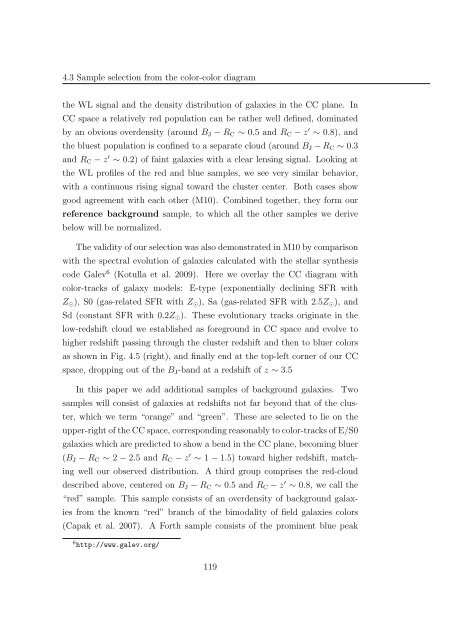Mass and Light distributions in Clusters of Galaxies - Henry A ...
Mass and Light distributions in Clusters of Galaxies - Henry A ...
Mass and Light distributions in Clusters of Galaxies - Henry A ...
You also want an ePaper? Increase the reach of your titles
YUMPU automatically turns print PDFs into web optimized ePapers that Google loves.
4.3 Sample selection from the color-color diagram<br />
the WL signal <strong>and</strong> the density distribution <strong>of</strong> galaxies <strong>in</strong> the CC plane. In<br />
CC space a relatively red population can be rather well def<strong>in</strong>ed, dom<strong>in</strong>ated<br />
by an obvious overdensity (around B J − R C ∼ 0.5 <strong>and</strong> R C − z ′ ∼ 0.8), <strong>and</strong><br />
the bluest population is conf<strong>in</strong>ed to a separate cloud (around B J − R C ∼ 0.3<br />
<strong>and</strong> R C − z ′ ∼ 0.2) <strong>of</strong> fa<strong>in</strong>t galaxies with a clear lens<strong>in</strong>g signal. Look<strong>in</strong>g at<br />
the WL pr<strong>of</strong>iles <strong>of</strong> the red <strong>and</strong> blue samples, we see very similar behavior,<br />
with a cont<strong>in</strong>uous ris<strong>in</strong>g signal toward the cluster center. Both cases show<br />
good agreement with each other (M10). Comb<strong>in</strong>ed together, they form our<br />
reference background sample, to which all the other samples we derive<br />
below will be normalized.<br />
The validity <strong>of</strong> our selection was also demonstrated <strong>in</strong> M10 by comparison<br />
with the spectral evolution <strong>of</strong> galaxies calculated with the stellar synthesis<br />
code Galev 6 (Kotulla et al. 2009). Here we overlay the CC diagram with<br />
color-tracks <strong>of</strong> galaxy models: E-type (exponentially decl<strong>in</strong><strong>in</strong>g SFR with<br />
Z ⊙ ), S0 (gas-related SFR with Z ⊙ ), Sa (gas-related SFR with 2.5Z ⊙ ), <strong>and</strong><br />
Sd (constant SFR with 0.2Z ⊙ ). These evolutionary tracks orig<strong>in</strong>ate <strong>in</strong> the<br />
low-redshift cloud we established as foreground <strong>in</strong> CC space <strong>and</strong> evolve to<br />
higher redshift pass<strong>in</strong>g through the cluster redshift <strong>and</strong> then to bluer colors<br />
as shown <strong>in</strong> Fig. 4.5 (right), <strong>and</strong> f<strong>in</strong>ally end at the top-left corner <strong>of</strong> our CC<br />
space, dropp<strong>in</strong>g out <strong>of</strong> the B J -b<strong>and</strong> at a redshift <strong>of</strong> z ∼ 3.5<br />
In this paper we add additional samples <strong>of</strong> background galaxies. Two<br />
samples will consist <strong>of</strong> galaxies at redshifts not far beyond that <strong>of</strong> the cluster,<br />
which we term “orange” <strong>and</strong> “green”. These are selected to lie on the<br />
upper-right <strong>of</strong> the CC space, correspond<strong>in</strong>g reasonably to color-tracks <strong>of</strong> E/S0<br />
galaxies which are predicted to show a bend <strong>in</strong> the CC plane, becom<strong>in</strong>g bluer<br />
(B J − R C ∼ 2 − 2.5 <strong>and</strong> R C − z ′ ∼ 1 − 1.5) toward higher redshift, match<strong>in</strong>g<br />
well our observed distribution. A third group comprises the red-cloud<br />
described above, centered on B J − R C ∼ 0.5 <strong>and</strong> R C − z ′ ∼ 0.8, we call the<br />
“red” sample. This sample consists <strong>of</strong> an overdensity <strong>of</strong> background galaxies<br />
from the known “red” branch <strong>of</strong> the bimodality <strong>of</strong> field galaxies colors<br />
(Capak et al. 2007). A Forth sample consists <strong>of</strong> the prom<strong>in</strong>ent blue peak<br />
6 http://www.galev.org/<br />
119
















